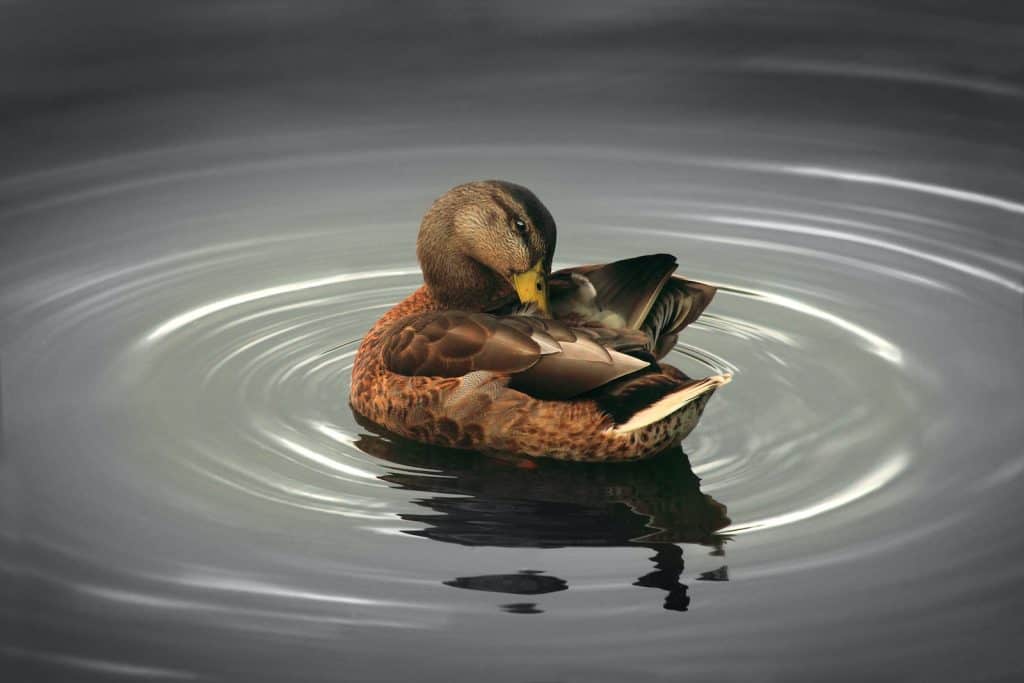
The Swedish yellow duck is a combination of three domestic species. These ducks are rare but they are still very attractive because of their calm temperament and triple-purpose usage.
Depending on where you are located on the map, it might be difficult to find the Swedish yellow duck. If you’re lucky enough to find one of these beautiful birds at your local hatchery, or breeder they can be very easy to care for and make wonderful pets. Let’s find out more.
Here are some quick facts about Swedish Yellow Ducks
| Name of the breed: | Svensk Gul Anka (Swedish Yellow Duck) |
| Where is it from? | Sweden |
| Uses: | Triple purpose |
| Drake Size | 7-8 pounds |
| Duck Size | 6.5-7.5 pounds |
| Color: | Yellow and brown |
| Lifespan: | 8-12 years |
| Climate Tolerance: | Cold-hardy |
| Care Level | Moderate |
| Production: | Moderate |
| Temperament: | Calm |
Mans Eriksson developed the Swedish Yellow Duck in Skane, Sweden. Although there is some debate about the actual ducks that were used to create this yellow waterfowl it has been suggested that they may have Blue Swedish, Khaki Campbells, and a local breed of white duck.
In the 1930s, Swedish yellow ducks were quite common. These waterfowl were developed in the 20th century and ended up filling farms all across Sweden. They became what he considered a rare duck breed in the 1950s.
They are not believed to be alive today but have been confirmed in Sweden.

Swedish Yellow Duck Characteristics
The wonderful temperament of the Swedish yellow duck makes them a great pet for both children and adults. They are easy to handle and nearly flightless, so you can use them for school projects or other structured activities.
The Swedish yellow duck spends its time in the barnyard, hopping around. Like all waterfowl, they love having a water source close by. While males may be aggressive towards other ducks during mating seasons, they should be gentle and docile.
This duck is a very active and healthy bird that can be used to forage.
Uses
The Swedish yellow duck is the perfect combination of both the traditional and modern worlds. These birds can be used for ornamental, egg, and meat production purposes. You will be amazed at their versatility and why they have not seen a revival in popularity.
They are an uncommon breed so we do not recommend using them as meat. There are plenty of large meat ducks that would be better suited for this situation. They are delicious and robust meat birds.
Although these ducks lay large quantities of white eggs, they may also produce grayish or bluish eggs. They can usually lay 130 eggs per year.
These ducks are blue-Swedish heritage and often brood, making them excellent mothers. Even if they don’t have their own eggs to brood, they are happy to care for other ducks and even chicken eggs.

Appearance and Varieties
Most Swedish yellow ducks are yellow, as their name suggests. The males are sexually dimorphic because they have brown heads. The males are slightly heavier than their female counterparts, by about a pound or so.
This breed is sometimes called yellow. You’ll notice that they are more yellowy-brown to buff in color. This appearance was created by mixing white ducks, Khaki Campbells, and Swedish ducks.
Population/Distribution/Habitat
The availability of Swedish yellow ducks is limited in today’s world.
- Population: All Swedish ducks are estimated to number around 130 breeding birds in their native Sweden. These do not include the Swedish Yellow ducks. There are many other Swedish waterfowl. No definitive numbers are available per our research.
- Distribution: While the availability of Swedish yellow ducks was once quite wide, they now only exist in Sweden. This means that unless you are a native of Sweden, it will be difficult to locate these beautiful buff ducks.
- Habitat: Swedish yellow ducks, like all waterfowl species, love to be near water. The ideal situation is to have more water. They can still live a happy life as long as there is a clean, fresh water source. Their nostrils can become clogged with debris, which can lead to death. These ducks are nesting animals and will require shelter as well as roosting areas. You have two options: allow the ducks to roam free or keep them in an enclosed area. These ducks can be kept inside without a high fence because they are mostly flightless. They are easy prey for predators due to their low defenses, lack of flight ability, and poor defenses. You must take safety precautions to ensure the safety of your flock.

Is the Swedish Yellow Duck good for small-scale farming?
Because of their versatility, the Swedish yellow ducks can be used in small-scale agriculture. You won’t be able to access the species unless you are a resident of Sweden.
Other ducks may also be available, like the Khaki Campbell or Swedish Blue. Other waterfowl may also be similar to the Swedish Yellow, such as the Buff Orpington duck.
Are Swedish ducks nice pets?
Blue Swedish Ducks are typically regarded as excellent pets because of their peaceful demeanor; the only exception is during the mating season, when they may exhibit aggressive behavior toward other ducks (males or females). They are quite energetic and one of the heartiest kinds.
Are Swedish ducks peaceful?
They are aggressive foragers with a peaceful demeanor. They are a very loud breed. Ladies have a loud shouting quack, whilst males have a low-pitched tone but can boost the volume of their quack to compete with the females.
What is the finest duck for a backyard?
The most common backyard duck breed is the Pekin. The most common backyard duck breed is the Pekin.
Which duck makes the most noise?
The loudest duck in the Chinese children’s story is the one who is shot.
What is the most silent duck?
Muscovy ducks are the most silent of all duck breeds. It doesn’t make any noise or create any trouble unless it is startled, assaulted, or occasionally joyful.
How large do Swedish ducks grow?
The Swedish is a medium-sized bird weighing 6.5 to 8 pounds. It has an oval head, a medium-length bill that is virtually straight along the top line, and a stocky body with a carriage that is about 20 degrees above horizontal. The duck and drake have uniform bluish slate plumage with a white bib.
How can you differentiate a male Swedish duck from a female?
Males have a deeper blue head and a somewhat greenish tinge to their bill, whilst females are all the same hue, including the bill. There are also Black Swedish ducks and Splashed, or Silver Swedish ducks, which are not suitable for display but make excellent pets or utility ducks.
How can you distinguish between a male and a female black Swedish duck?
The Black Swedish ducks are all black with the exception of a white spot on the chest and wings. They are around the size of a Pekin Duck. They make a lot of noise. The female quacks in a yelp-like tone, whereas the male quacks in a low-pitch tone.
What colors do Swedish duck eggs have?
Swedish ducks are tough and adept foragers. Drakes will weigh around six pounds. Hens may weigh up to five pounds and lay predominantly white eggs with the exception of the rare blue or gray colored egg.